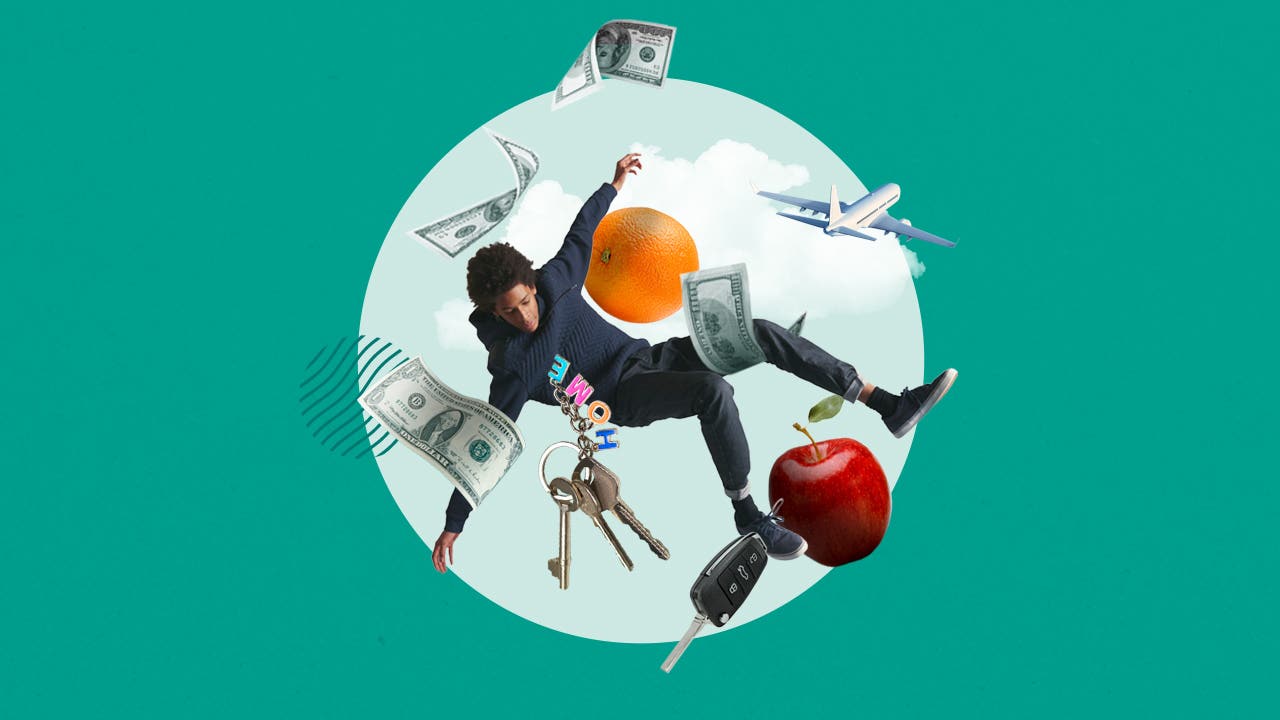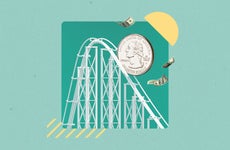Inflation slowed again in June but some items are still pricey — here’s what’s rising most

The Bankrate promise
At Bankrate we strive to help you make smarter financial decisions. While we adhere to strict , this post may contain references to products from our partners. Here's an explanation for .
Key takeaways
- The current annual inflation rate is 3%, but between May and June, inflation edged lower (-0.1%) on a monthly basis, the first decline since the pandemic.
- Prices are still 20.8% more expensive since the pandemic-induced recession began in February 2020, with just 6% of the nearly 400 items the Bureau of Labor Statistics tracks cheaper today.
- The Federal Reserve is closely monitoring inflation and has raised interest rates to combat it, but officials are looking for more confidence that they can begin to trim interest rates.
Inflation looks like it’s finally trending in the right direction, and even the items that have remained stubbornly hot are beginning to slow down — clearing a path for the Federal Reserve to start cutting interest rates later this year.
Inflation in June rose 3 percent from a year ago, down from a 3.3 percent rate in May and returning back to the lowest levels since early 2021, according to the Bureau of Labor Statistics’ monthly consumer price index (CPI) report. On a month-over-month basis, prices actually fell 0.1 percent, the first decrease in the monthly inflation rate since the early days of the pandemic.
The decline is a positive sign for U.S. central bankers, who have been sticking with the highest interest rates in over two decades to cool inflation despite its potential consequences: higher unemployment and, the worst-case scenario, a recession.
Even with the good news, consumers may still feel the pinch of inflation. Since February 2020, consumer prices have increased 20.8 percent, a Bankrate analysis of Bureau of Labor Statistics data shows. That’s well above the historic average for a four-year period. For comparison, inflation rose 18.9 percent in the 2010s, 28.4 percent in the 2000s and 32.4 percent in the 1990s. The post-pandemic price burst means Americans would need about $1,208 to buy the same goods and services that cost $1,000 when the coronavirus-induced recession occurred.
A little bit of inflation is good for consumers. The economy keeps growing and businesses continue expanding, hiring workers and bumping up their pay along the way. Too much inflation, however, feels akin to taking a pay cut. High inflation has consequences beyond just affordability, complicating saving for emergencies or investing for retirement.
Looking for the latest information on consumer prices? Here’s a round-up of where inflation is improving — and where it’s still remaining stubborn.
With abundant signs of a cooling economy, the CPI for June certainly constitutes the ‘more good data’ on inflation that Fed Chair Jerome Powell has said we need to see before the Fed can begin cutting interest rates. With both headline and core readings coming in lower than expected, this aligns with a September interest rate cut.— Greg McBride, CFA , chief financial analyst for Bankrate
Highlights of the latest statistics on inflation
- Overall inflation in June 2024: 3%, down from 3.3% in May
- Core prices (excluding food and energy): 3.3%, down from last month’s 3.4% increase
- Food prices: 2.2%, edging up from 2.1% in May but matching the 2.2% level from April and March
- Food away from home (dining out at restaurants): 4.1%, up slightly from 4%
- Food at home (groceries): 1.1%, up slightly from 1%
- Services: 5%, down from 5.2% in May and April
- Energy: 0.9%, down rapidly from 3.5% in May
- Gasoline: -2.5%, down from a 2.2% increase in May
- Motor vehicle insurance: up 19.5%, down from 20.3% in May, 22.6% in April and 22.2% in March
- New vehicles: -0.9%, down from -0.8% in May and -0.4% in April
- Used cars and trucks: -9.5%, down from -8.6% in May, -6.3% in April and -1.9% in March
What is the current inflation rate?
Inflation rose 3 percent in June from a year ago, marking three straight months of slowing inflation, the latest Bureau of Labor Statistics report showed. Excluding the volatile food and energy categories, so-called core prices also dipped to 3.3 percent from 3.4 percent, the lowest since April 2021.
Taken together, the figures reflect a return to the disinflation that had been benefiting consumers and policymakers on the Federal Reserve in the second half of 2023. Inflation is also still well below its peak in June 2022, when it smashed 9.1 percent.
Prices that are rising the most
Of the nearly 400 items that BLS tracks, about 2 in 3 (or 67 percent) increased in price between June 2023 and 2024.
According to BLS, these are the prices that increased most over the past year:
| Item | June 2023-June 2024 increase |
|---|---|
| *Denotes an item that isn’t seasonally adjusted | |
| Frozen noncarbonated juices and drinks* | 20.2% |
| Motor vehicle insurance | 19.5% |
| Video discs and other media* | 18.3% |
| Admission to sporting events | 15.1% |
| Care of the sick and elderly at home* | 11.4% |
| Uncooked meats, other than beef and veal* | 10.5% |
| Eggs | 10.2% |
| Photographic equipment and supplies | 10.1% |
| Uncooked beef roasts | 10% |
| Indoor plants and flowers | 9.4% |
Month-over-month price changes, however, can give consumers a more real-time look at the prices that have recently been popping — or slowing. Lower prices in the same year-ago period, for example, can cause an item to look like it’s gaining speed, when it’s slowing in reality.
Case in point: Back in May, energy prices rose 3.5 percent over the 12-month period, appearing to be gaining speed from the April’s 2.5 percent annual increase despite dipping 2 percent over the month. The reason for the discrepancy? May 2023 was a cheaper month for energy costs.
Consumers, however, should take seasonal variations into account. BLS doesn’t seasonally adjust all of its items, and year-over-year inflation rates can better smooth out those variations.
According to BLS, these are the prices that increased most over the past month:
| Item | May 2024-June 2024 increase |
|---|---|
| Women’s outerwear | 5.9% |
| Jewelry | 4.4% |
| Other intercity transportation | 3.6% |
| Eggs | 3.5% |
| Citrus fruits | 3.2% |
| Pork chops | 3.1% |
| Uncooked meats, other than beef and veal | 3% |
| Window coverings | 3% |
| Margarine | 2.9% |
| Recreational books | 2.8% |
Why is inflation so high right now?
Consumers might look at the massive 20.2 percent increase in frozen noncarbonated drink prices and wonder why the overall inflation rate is just 3 percent. To put it simply, the Bureau of Labor Statistics assigns weights to each individual good or service it tracks, based on how prevalent it’s considered to be in a consumer’s monthly budget.
Currently, the main contributors to inflation are shelter and motor vehicle insurance, though housing is beginning to improve. Rent of primary residence, for instance, rose by the slowest pace since 2021.
- Rent accounted for 60 percent of the annual 3 percent increase in June.
- Motor vehicle insurance, meanwhile, contributed 17 percent to this month’s annual inflation rate.
- Put another way, inflation would’ve risen 2.5 percent in June had motor vehicle insurance prices remained stable and 1.2 percent had rents not increased.
“One-in-a-row is not a streak,” McBride says. “But more readings like this in the months ahead is consistent with getting inflation down to a 2 percent annual rate.”
The drivers of inflation have changed dramatically since the initial post-pandemic price burst. When price pressures peaked in June 2022, shelter was driving just 20 percent of the annual increase in prices. But as consumers emerged from lockdowns with massive pent-up demand at the same time as global supply shortages, energy was driving about a third (32 percent) of inflation, while food prices were driving 15 percent of inflation.
The changing drivers of inflation have evolved as much as the U.S. economy. Supply chains have untangled since the pandemic, helping take the pressure off of goods inflation. However, services such as rent, insurance and even the price of dining out can take months, if not years, to fluctuate — depending on what’s happening with labor costs and consumer spending.
To combat inflation, officials on the Federal Reserve have lifted borrowing costs from a rock-bottom level of near-zero percent to a 23-year high of 5.25-5.5 percent. Yet, the U.S. economy has remained surprisingly resilient, underpinned by booming hiring.
Post-pandemic inflation: What’s risen the most and what’s gotten cheaper
Of the nearly 400 items BLS tracks, just 21 (or roughly 6 percent) are cheaper today than they were pre-pandemic. More than 2 in 5 (46 percent) of those items rose at a faster clip than overall inflation.
To be sure, prices are expected to rise in the healthiest of economies — though only gradually, at a goalpost of around 2 percent a year.
According to BLS, these are the top 10 items that have jumped the most in price since the pandemic:
| Item | February 2020-June 2024 increase |
|---|---|
| *Denotes an item that isn’t seasonally adjusted | |
| Margarine | 56.4% |
| Frozen noncarbonated juices and drinks* | 51.3% |
| Eggs | 49.3% |
| Other fats and oils, including peanut butter | 47.8% |
| Motor vehicle insurance | 47.2% |
| Motor vehicle repair | 45.2% |
| Fuel oil | 42.8% |
| Crackers, breads and cracker products | 42.5% |
| Repair of household items | 41.6% |
| Leased cars and trucks | 41.5% |
Meanwhile, the items that have dropped in price the most since the pandemic are primarily goods and electronics — largely thanks to improving supply chains.
| Item | February 2020-June 2024 decrease |
|---|---|
| Smartphones* | -53.4% |
| Telephone hardware, calculators, and other consumer information items | -45.7% |
| Information technology commodities | -23.1% |
| Televisions | -22.1% |
| Education and communication commodities | -20.2% |
| Health insurance* | -17.8% |
| Computer software and accessories* | -16.3% |
| Other video equipment | -15.5% |
| Video and audio products | -12.5% |
| Men’s suits, sport coats and outerwear | -9.5% |
Inflation breakdown by product category
Looking for an easy analysis of how inflation is impacting the key items in your budget? Here’s what Bankrate found.
-
Over the past 12 months, gasoline prices have declined 2.5 percent, after jumping as much as 59.9 percent in June 2022. Yet, gas prices are still 28.4 percent more expensive today than before the pandemic. Consumers have likely experienced some volatility at the pump.
Energy prices tend to be volatile. Between March and April, prices at the pump increased across all 50 states between March and April, AAA data showed. Then, between April and May, they dipped in every state except Colorado. They’re back to rising again more broadly, in all but nine U.S. states.
-
Grocery prices (formally known as food at home) rose 1.1 percent from a year ago and are still 25.1 percent more expensive than they were before the pandemic, BLS data indicates. At their peak, grocery prices soared 13.5 percent in July 2022 from a year ago.
Of the major shopping categories:
- Meats: up 3.5 percent over the past year and 26.6 percent since February 2020
- Fish and seafood: down 1 percent from a year ago but still up 16.4 percent since the start of the pandemic-induced recession
- Dairy: down 0.1 percent over the past year but still 19.2 percent more expensive since the pandemic
- Fruits and vegetables: down 0.5 percent over the past year and 16.7 percent more expensive than before the pandemic
- Sugar and sweets: up 2 percent from a year ago and 28.3 percent since the pandemic
Meanwhile, the price of dining out (formally known as full service meals and snacks) jumped 3.9 percent from a year ago, capping off a 26 percent increase since the pandemic.
-
Rent has become one of the most costly categories of a consumer’s budget, but the tide may be turning — albeit slowly.
Rent of primary residence in April jumped 5.1 percent from a year ago, BLS data shows. To be sure, rent prices aren’t rising as quickly as they once were, at one point surging 8.8 percent over a 12-month period back in March and April 2023. Yet, Americans who’ve had to sign new leases since the outbreak are feeling the pinch: Rent is up 23.9 percent since the pandemic.
Real-time measures show that rents aren’t rising as quickly as they were at the height of post-pandemic lockdowns, though a sharper slowdown hasn’t yet been reflected in the official BLS monthly report. One reason could be because of lags, even longer than usual for shelter prices as leases and housing agreements take longer to roll over from the previous year. Another could simply be because homes have stayed pricey, keeping more renters on the sidelines than usual.
-
Inflation hasn’t just made the prices of key household essentials — but the costs of vacations and travel, too. Airline ticket prices, for example, once soared as much as 43 percent from a year ago in September 2022.
Those prices are finally starting to level off, though a resurgence in fuel and energy costs could jeopardize that slowdown in prices.
- Airfares: down 5.1 percent from a year ago and 9.4 percent cheaper since February 2020
- Car and truck rental: down 6.3 percent from a year ago but up 19 percent since the pandemic
- Hotels and motels (lodging away from home): down 2.8 percent from last year but 10.5 percent more expensive than before the pandemic
-
Owning a car has been especially pricey since the pandemic, from the cost of the car itself and the interest rates that finance it to the repair and insurance costs required for upkeep. Making car inflation hard to escape, the majority of households (roughly 92 percent) owned at least one car in 2022, according to the Census Bureau.
- Motor vehicle insurance: up 19.5 percent from a year ago and 47.2 percent since the start of the pandemic in 2020
- Vehicle repair: up 6.7 percent from a year ago and 45.2 percent since February 2020
- New vehicles: down 0.9 percent since April 2023 but still 19.3 percent more expensive since February 2020
- Used vehicles: down 9.5 percent since April 2023 but 27.2 percent more expensive
- Leased vehicles: up 4.3 percent from a year ago and 40.4 percent since the start of the pandemic
The different methods of measuring inflation: PCE versus CPI
- Overall inflation in May 2024: 2.6% from a year ago, down from 2.7% in April and March
- Core prices (excluding food and energy): 2.6% from a year ago, down from 2.8% in April, May and February
- Food prices: up 1.2% from a year ago, down from 1.2% in April
- Services: up 3.9% from a year ago, down slightly from 4% in April
- Energy goods and services: up 4.8% from a year ago, an increase from 3% in Apriil
Fed policymakers look at the full picture of economic data when setting interest rates. But officially, they prefer a different measure to see whether they’re succeeding at controlling inflation: the Department of Commerce’s personal consumption expenditures (PCE) index.
But that preference has been keeping Fed watchers on their toes. Lately, the PCE index has been indicating slower inflation, with overall prices more than half a percentage point above the Fed’s target — compared to a hotter one percentage point as shown with CPI.
Those variations have always been afoot. Mainly, they’re because of methodology differences. For starters, PCE takes consumers’ substitutions into account (for example, one family’s decision to buy fish over meat for one month because it’s cheaper).
But another key difference is to blame lately. Both agencies estimate an item’s relative importance differently, with BLS’ gauge giving the most weight to the category of inflation that’s coincidentally been the hottest: shelter.
For Fed officials, the story remains largely the same: Inflation is slowing but still stubbornly above their 2 percent goalpost. Yet, when officials do decide to change policy — including cutting interest rates — the variations could make the decision trickier. Fed officials don’t want to risk cutting interest rates too soon, for fear that it could stoke even higher inflation if it causes demand to rise again.
QUOTE
Takeaways for consumers
For consumers, the message is clear: Inflation has cooled dramatically since peaking in the summer of 2022, though it remains undefeated. The ultimate question now is whether the U.S. economy’s resilience is keeping inflation elevated. If it is, the Fed might need to slow the financial system down more to finish the job, ultimately risking consumers’ paychecks and employment if it dents the robust job market.
- Expect higher-for-longer rates from the Fed: Fed Chair Jerome Powell has said that officials need to cut interest rates long before prices hit 2 percent on an annual basis. If they don’t, they risk slowing the economy down too much for too long. Yet, officials say they need more confidence that inflation is retreating back to their target, meaning interest rates are likely to remain high — keeping borrowing costs expensive but savings yields lucrative.
- Comparison shop as much as you can: Consumers know to compare offers from multiple lenders before locking in a loan. Why not the same for the items you buy on a regular basis? Comparison shopping can help make sure you’re buying the cheapest product on the market. Compare prices at multiple retailers, see if any stores offer price match and craft a budget. If a product or ingredient pushes your spending goal over the edge, consider swapping it out for something else.
- Use the personal finance tools at your disposal: Finding the right credit card that helps you earn rewards on the purchases you were already going to make can be another way to pad up your wallet. Just be sure you’re not carrying a balance. A 20.71 percent interest rate will never outweigh the cash back.
- Save for emergencies and find the right account: Historically, investing in the markets has been the best way to beat inflation, but today’s high-rate era means savers can find a market-like return without any of the risk. Stash your cash in a high-yield account or add a longer-term CD to your portfolio, so you can lock in these elevated yields for the long haul.
See how all items BLS regularly tracks have changed over time
-
Bankrate analyzed 380 items from the Bureau of Labor Statistics’ consumer price index (CPI) to determine how much specific items have increased in price on both a month-over-month basis, year-over-year basis and then on a pre-pandemic basis (defined as February 2020, when the coronavirus pandemic-induced recession was officially determined to have begun). Bankrate then ranked each item from slowest to fastest appreciation, focusing on the top and bottom 10 in each category, in addition to key aspects of Americans’ budgets. When given the choice, Bankrate chose an item’s seasonally adjusted index.
Related Articles

Red-hot inflation is raising prices on everyday essentials — here’s what’s rising the most

Even after inflation cools, Americans could still be paying the price

Survey: Inflation has likely peaked, but consumers will still pay more this year

What is inflation? Here’s how rising prices can erode your purchasing power